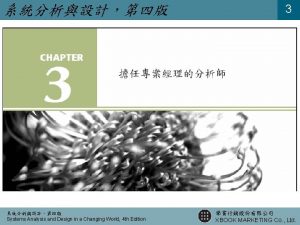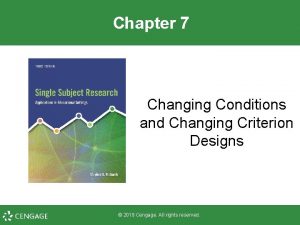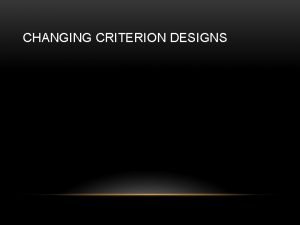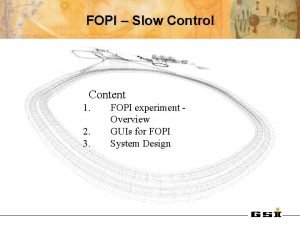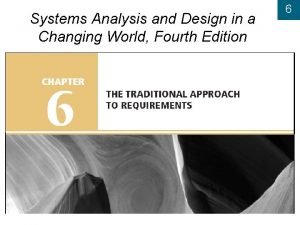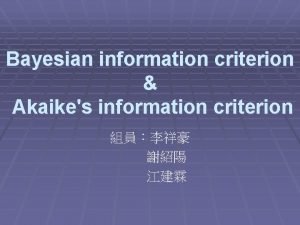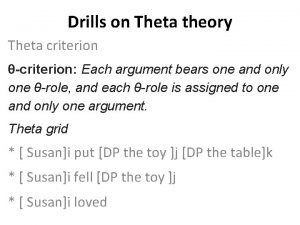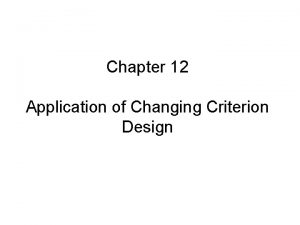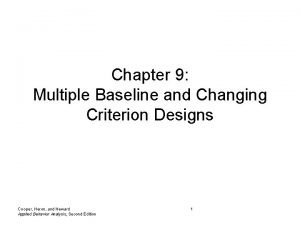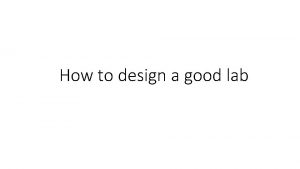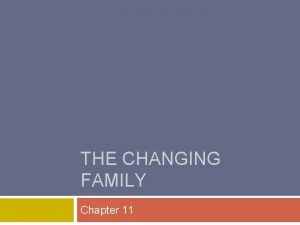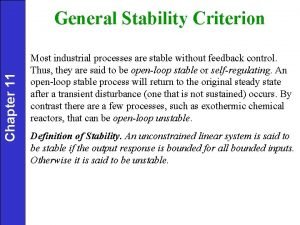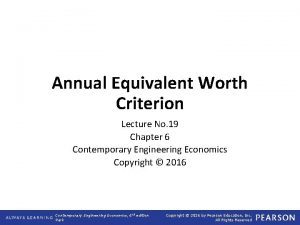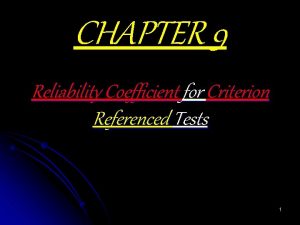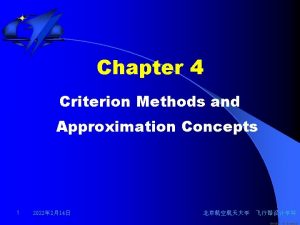Chapter 11 Overview of Changing Criterion Design Changing






















- Slides: 22

Chapter 11 Overview of Changing Criterion Design

Changing Criterion Design ¨ Involves the evaluation of the effects of a treatment on the gradual, systematic increase or decrease of a single target behavior ¨ Frequently used when reinforcement or punishment contingencies are in effect ¨ This is done by changing, in a stepwise fashion, the criterion levels necessary to meet contingencies to increase behavior (positive or negative reinforcement) or to decrease behavior (differential reinforcement procedures or punish)

Changing Criterion Design Continued ¨ It is considered a variation of the A-B Design ¨ In changing Criterion Design, After baseline data are collected (A), the treatment phase (B) is divided into Subphases – Each subphase require changes in the target behavior that more closely approximate the terminal behavior or goal

The Six Steps of Changing Criterion Design Step 1 - Define the target behavior. – the behavior should be able to change gradually and in a stepwise fashion Step 2 Collect baseline data. – Data should be gathered until they are stable and/or moving in a counterproductive fashion

The Six Steps of Changing Criterion Design Step 3 - Determine level of performance require for the contingent presentation of the reinforcement or punishment A) Determine goal of behavior B) Determine criterion level for the first subphase

Determining Criterion Level 1. Determine terminal behavior or goal 2. Determine criterion level for the first subphase by a) Setting the criterion level at the mean of the stable portion of the baseline data, particularly if the initial rate of responding is low b) Taking 50% of the average of the baseline data and add to the average

Determining Criterion Level Continued c) Choosing the highest or lowest data point and use that as the criterion level, useful for social behaviors d) Use professional judgment 3. Establish the criterion levels for the subsequent subphase. This usually involves a gradual increase or decrease in the criterion levels in the direction of the goal.

The Six Steps of Changing Criterion Design Continued Step 4 - Begin the intervention. The criterion required to obtain the treatment is applied. Step 5 - Introduce the next subphase level after the initial criterion level is met. Step 6 - Continue through each subphase in a stepwise fashion until the terminal goal is reached

Issues Related to Changing Criterion Designs ¨The length of each phase ¨The magnitude of the criterion changes, and ¨The number of phases or criterion changes

Length of Each Phase ¨Phase should be long enough to allow stable responding ¨Length of phase should be varied if possible

Magnitude of the Criterion Changes ¨Should not be too large or too small ¨Use baseline data to help make the determination

Number of Criterion Changes ¨ The number of criterion changes actually refers to the number of phases (subphases) that should be included in the study ¨ The determination will depend on both the length of the phases and the magnitude of the criterion changes ¨ The greater the magnitude of the criterion changes, the fewer the number of phases before the target goal is met ¨ The more times the target behavior changes to meet a new criteria, the more control is demonstrated

Prediction, Verification, & Replication ¨ Prediction of the levels of future behaviors is made when stable responding is attained with in each phase ¨ Replication occurs every time that the behavior changes in the predicted direction based on the predetermined criterion levels

Prediction, Verification, & Replication ¨ Verification is possible when either of two of the previously discussed suggestions to increase internal validity are made – It is demonstrated when the direction of the criterion levels is reversed and the behavior returns to a previously set criterion level

Advantages Changing Criterion Design ¨ Withdrawal of treatment not necessary ¨ Good design to evaluate contingency programs to increase or decrease behavior ¨ Gradual change in target behavior results in educationally or clinically appropriate outcomes ¨ It can be helpful to use when the terminal goal that is set takes a relatively long time to reach

When to Use Changing Criterion Design ¨ When the target behavior can change gradually in a stepwise fashion ¨ When the behavior is already in the subject’s repertoire and needs to be increase or decreased ¨ When the effects of continent reinforcement or punishment procedures need to be evaluated ¨ When withdrawal of treatment is not appropriate

Disadvantages of Changing Criterion Design ¨ Target behavior must be able to change in a gradual, stepwise fashion, ¨ Requires time and effort to determine important parameters of the design (e. g. , the number and lengths of phases) ¨ Not appropriate for treatment approaches that do not use contingent procedures to increase or decrease behaviors

When not to Use Changing Criterion Design ¨ When the target behavior cannot be changed in a gradual, stepwise fashion ¨ When the target behavior is not in the subject’s repertoire ¨ When treatments other than the presentation of contingencies are being evaluated ¨ When time and effort cannot be given to determine the important parameters of the design (number and length of phases, magnitude of criterion changes)

Adaptations of the Changing Criterion Design ¨ Primarily involve – The addition of a phase or phases in which there is reversal to a previous criterion level or – A return to baseline Both adaptations are used to demonstrate greater experimental control of the independent and dependent variable.

Reversal to a Previous Criterion Level ¨ Instead of a steady, stepwise increase or decrease in the criterion levels, the criterion is reversed one or more times ¨ Provides additional evidence of the functional relationship between treatment and the target behavior

Reinstate Baseline Conditions ¨ More radical reversal in which the stepwise progression is interrupted by returning to baseline conditions ¨ The B phase is the stepwise criterion changes required for the representation of the contingencies

Reinstate Baseline Conditions Continued ¨ This design shows a powerful functional relationship between the independent and dependent variable ¨ It has the ethical liabilities of the withdrawal design because the subject is placed in a nontreatment phase ¨ A more powerful method of demonstrating experimental control
 Changing-criterion design
Changing-criterion design Advantages of changing criterion design
Advantages of changing criterion design Changing-criterion design
Changing-criterion design System design
System design System design overview
System design overview Gantt chart in system analysis and design
Gantt chart in system analysis and design Systems analysis and design in a changing world
Systems analysis and design in a changing world System analysis and design in a changing world
System analysis and design in a changing world Systems analysis and design in a changing world
Systems analysis and design in a changing world Systems analysis and design in a changing world
Systems analysis and design in a changing world Systems analysis and design in a changing world
Systems analysis and design in a changing world Systems analysis and design in a changing world
Systems analysis and design in a changing world System analysis and design in a changing world
System analysis and design in a changing world Systems analysis and design in a changing world
Systems analysis and design in a changing world A 23 year old male experienced severe head trauma
A 23 year old male experienced severe head trauma Chapter 14 medical overview
Chapter 14 medical overview Chapter 9 lesson 2 photosynthesis an overview
Chapter 9 lesson 2 photosynthesis an overview Chapter 12 selling overview
Chapter 12 selling overview Financial intermediaries
Financial intermediaries Chapter 1 overview of verb tenses
Chapter 1 overview of verb tenses Overview of personal finance chapter 1
Overview of personal finance chapter 1 Distoclusion definition
Distoclusion definition Foundations in personal finance chapter 1 test
Foundations in personal finance chapter 1 test
